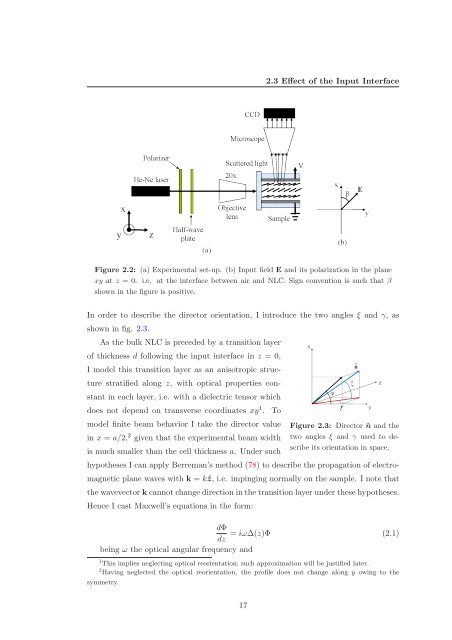Solitons in Nonlocal Media
Solitons in Nonlocal Media
Solitons in Nonlocal Media
Create successful ePaper yourself
Turn your PDF publications into a flip-book with our unique Google optimized e-Paper software.
2.3 Effect of the Input Interface<br />
Figure 2.2: (a) Experimental set-up. (b) Input field E and its polarization <strong>in</strong> the plane<br />
xy at z = 0. i.e. at the <strong>in</strong>terface between air and NLC. Sign convention is such that β<br />
shown <strong>in</strong> the figure is positive.<br />
In order to describe the director orientation, I <strong>in</strong>troduce the two angles ξ and γ, as<br />
shown <strong>in</strong> fig. 2.3.<br />
As the bulk NLC is preceded by a transition layer<br />
of thickness d follow<strong>in</strong>g the <strong>in</strong>put <strong>in</strong>terface <strong>in</strong> z = 0,<br />
I model this transition layer as an anisotropic struc-<br />
ture stratified along z, with optical properties con-<br />
stant <strong>in</strong> each layer, i.e. with a dielectric tensor which<br />
does not depend on transverse coord<strong>in</strong>ates xy 1 . To<br />
model f<strong>in</strong>ite beam behavior I take the director value<br />
<strong>in</strong> x = a/2, 2 given that the experimental beam width<br />
is much smaller than the cell thickness a. Under such<br />
Figure 2.3: Director ˆn and the<br />
two angles ξ and γ used to describe<br />
its orientation <strong>in</strong> space.<br />
hypotheses I can apply Berreman’s method (78) to describe the propagation of electro-<br />
magnetic plane waves with k = kˆz, i.e. imp<strong>in</strong>g<strong>in</strong>g normally on the sample. I note that<br />
the wavevector k cannot change direction <strong>in</strong> the transition layer under these hypotheses.<br />
Hence I cast Maxwell’s equations <strong>in</strong> the form:<br />
dΦ<br />
= iω∆(z)Φ (2.1)<br />
dz<br />
be<strong>in</strong>g ω the optical angular frequency and<br />
1 This implies neglect<strong>in</strong>g optical reorientation; such approximation will be justified later.<br />
2 Hav<strong>in</strong>g neglected the optical reorientation, the profile does not change along y ow<strong>in</strong>g to the<br />
symmetry.<br />
17
















